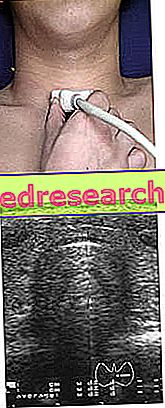Thyroid ultrasound is the reference diagnostic test for the morphological study of this gland.
How does it work
Like all ultrasound techniques, it is based on the different ability of the tissues to reflect the ultrasound emitted by an electric probe; the same device is able to record the intensity of the reflected waves, converting them into electrical signals and reconstructing the anatomical aspect of the thyroid in real time (thanks to a specific computer program).

The ultrasounds, with a very high frequency and inaudible to the human ear, are emitted by a special probe made to slide along the anterior region of the neck, previously sprinkled with a small amount of gel and positioned in hyperextension (the patient lies down on a cot, upside down and looking backwards).
The behavior of the ultrasounds therefore depends on the characteristics of the medium crossed and on the frequency with which they are generated.
Preparation, Risks, Contraindications
Thyroid ultrasound is a painless, rapid examination (takes about 10 minutes), safe and completely independent of ionizing radiation or radioactive substances.
No special preparation is required before the exam; it will simply be necessary to remove any jewelry worn around the neck. The investigation is absolutely risk free and without any contraindication.
Once the thyroid ultrasound is completed, the gel is removed and the patient can safely resume their activities.
When it is performed
The diagnostic accuracy of thyroid ultrasound depends essentially on the device used, the skill of the operator and patient-related technical limits.
More particularly, the ultrasound of the thyroid is particularly useful in defining the volume of the gland (goiter), the presence of inflammatory processes (thyroiditis), the possible presence of nodules and their particular characteristics. By combining the Doppler technique with ultrasound it is also possible to study the vascularization of the thyroid or of a single nodule, drawing important information about its functionality and metabolic activity.
The functional aspects of the gland can be investigated in greater depth through a further diagnostic examination, called thyroid scintigraphy, while to confirm the suspicion of malignancy it is necessary to evaluate the cell sample aspirated under ultrasound guidance.



